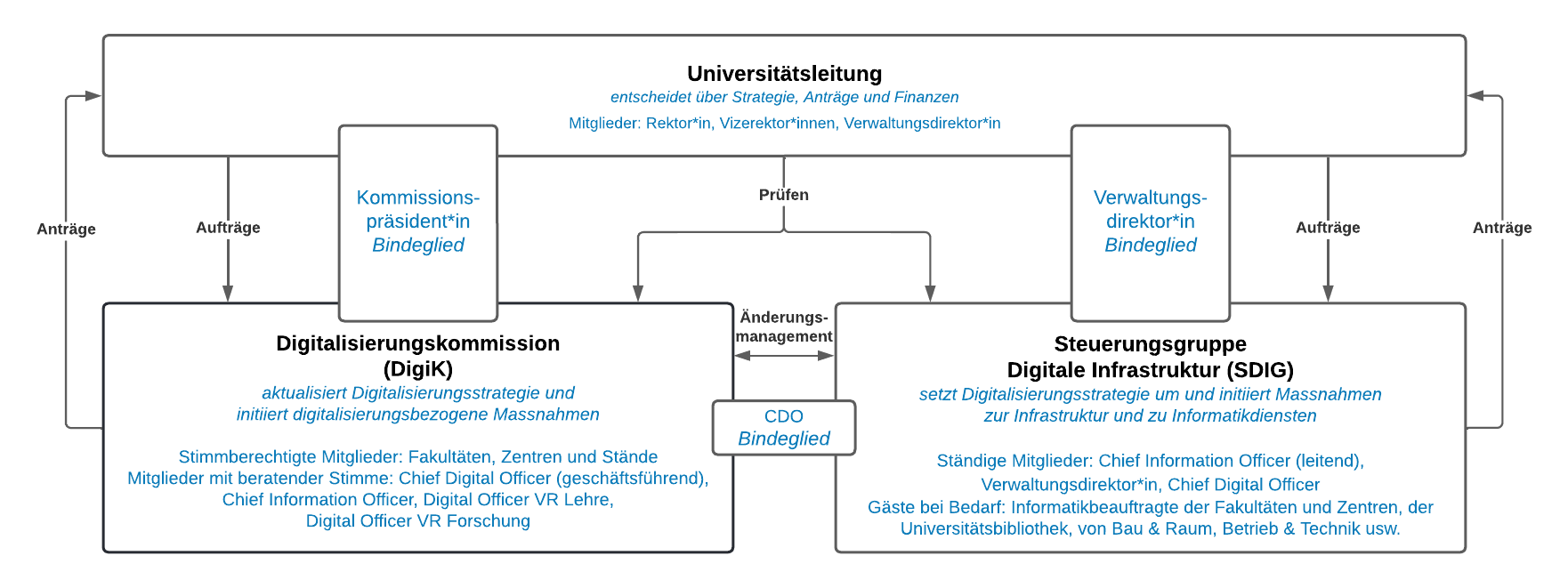Governance
The digitalization strategy will be implemented by the Executive Board of the University of Bern, the Digitalization Commission (DigiK) and the Digital Infrastructure Steering Group (SDIG) as part of a system of checks & balances.
For the successful implementation of the digitalization strategy, it will be essential that these committees receive the full support of all representatives of the interest groups spread throughout the University.
Within the governance structure, the Executive Board is, on the one hand, the ultimate decision-making body on strategic orientation, spheres of activity to be worked on, the implementation of measures, proposals from subordinate bodies and all financing issues. On the other hand, the Executive Board’s contribution to the implementation of the digitalization strategy is initially limited to providing credit lines, firstly to the Digitalization Commission for digitalization-related measures at University level in the field of academic research, teaching, continuing education and services, and, secondly, to the SDIG for digitalization-related measures at the University level in the area of central ICT infrastructure and central ICT services.
The Executive Board may determine strategic guidelines for the utilization of the credit lines; however, it does not specify specific guidelines for the use of funds. In addition, the Executive Board regularly reviews the digitalization measures initiated at the suggestion of the DigiK or SDIG as well as their results to ensure that they are achieving their objectives.
The DigiK consists of 13 members with voting rights, representing the faculties (8), the strategic centers (1), the lecturers and assistants (2) and the students (2). The President is elected from among the faculty representatives for a one-year term of office as a link to the Executive Board.
To ensure the flow of information, the DigiK is supplemented by four members in an advisory capacity, namely the Chief Digital Officer (CDO) of the University of Bern, the Chief Information Officer (CIO) of the University of Bern and the Digital Officers of the Vice-Rectorates Teaching and Research.
The DigiK regularly reviews and updates the digitalization strategy of the University of Bern, submits applications for the use of the credit line issued by the Executive Board, initiates its own digitalization-related projects, reviews and advises on funding requests from faculties or associations, and makes recommendations on the use of funds to the Executive Board. The CDO of the University of Bern acts as the managing director and liaison with the SDIG and is also responsible for monitoring compliance with strategic plans at a subordinate operational level.
In addition to the CIO of the University of Bern in a leading position, the SDIG also includes as permanent members the Director of Administration of the University of Bern as a link to the Executive Board and the CDO of the University of Bern as a link to the DigiK.
Invitations to SDIG meetings shall be made as required to: Managers from centralized ICT-related units (IT Services, iLUB, University Library), managers from decentralized IT organizational units (faculties, institutes, centers) or managers from departments with a reciprocal dependence on centralized ICT services (e.g. Operations & Technology, Construction & Planning).
The SDIG manages the implementation of the digitalization strategy at the operational level in accordance with the specifications of the Executive Board, and possibly also the DigiK. It also initiates its own digitalization-related projects at the operational level and, if necessary, delegates responsibilities to specific steering groups for subdivisions if the complexity and variety of topics of these subdivisions require this. The CIO informs the faculties, centers and intermediate staff and students about SDIG activities at meetings of the DigiK, while the Director of Administration acts as the link to the Executive Board.
The outlined lean governance structure aims to promote agile decision-making processes while at the same time ensuring the substantial involvement of the faculties, centers and intermediate staff and students in the establishment and implementation of strategic projects relevant to digitalization.
The monitoring function performed by the Executive Board also guarantees the proper use of funds, including closed quality assurance cycles, and also ensures that digitalization projects funded at University level are aligned with strategic planning at the faculty level.

